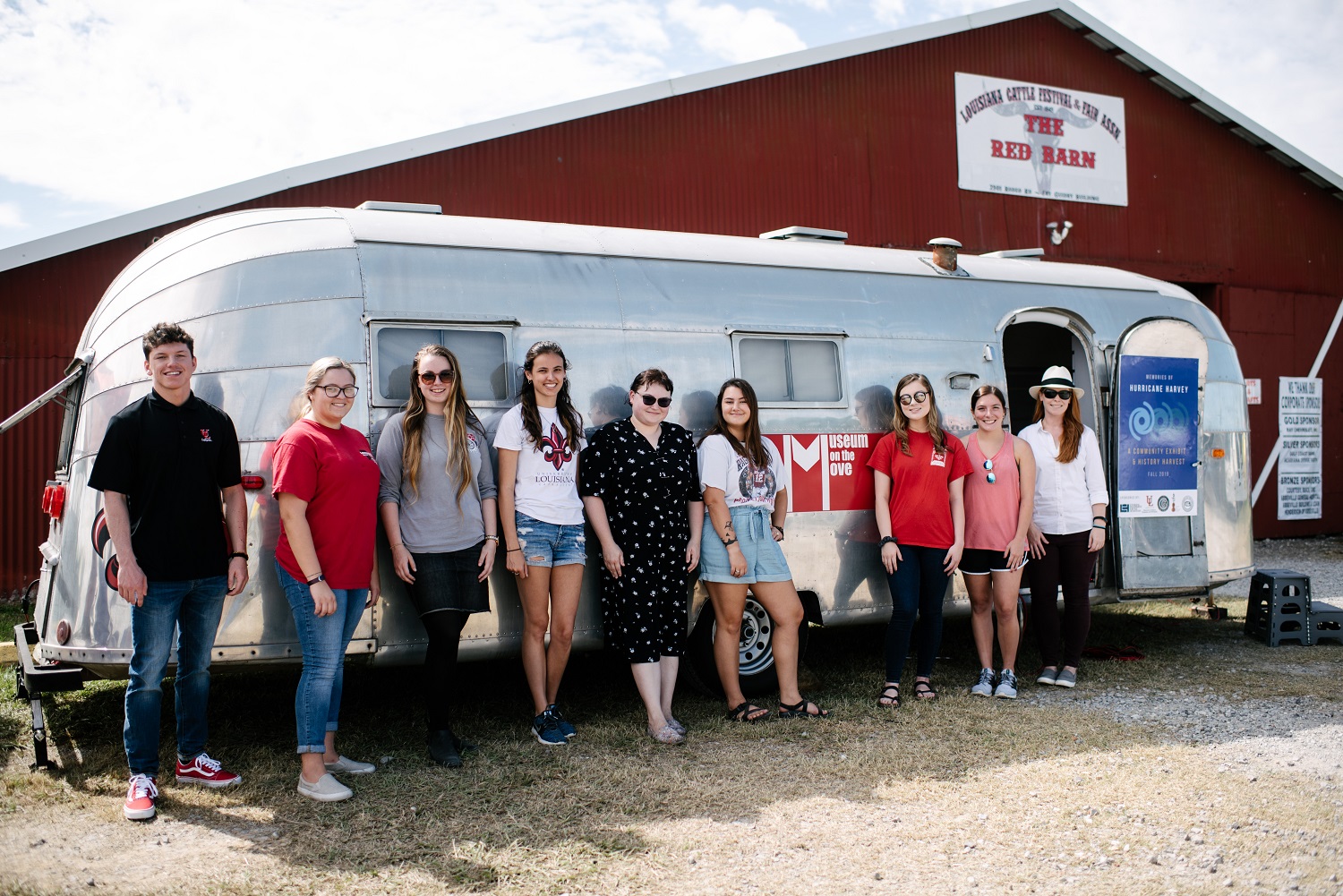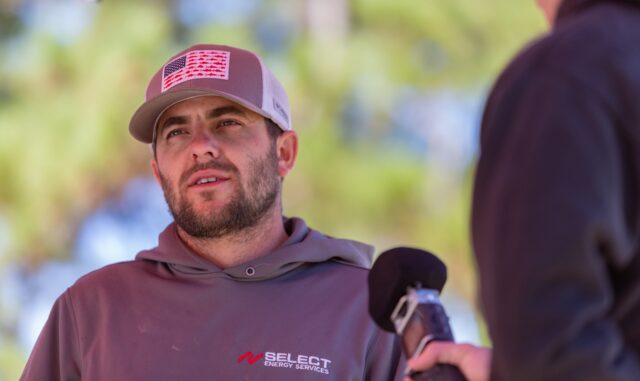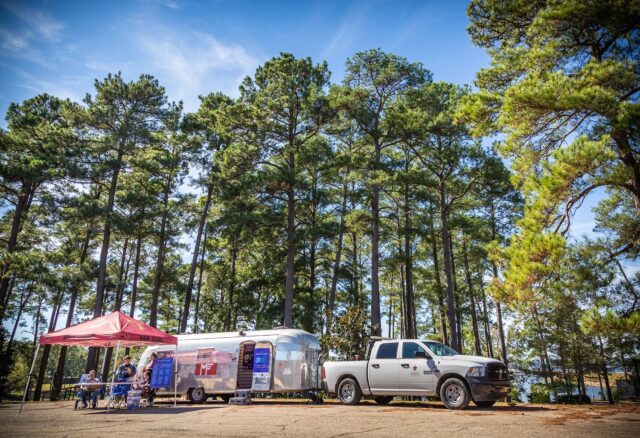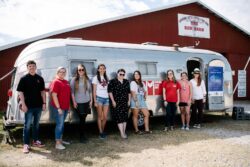Harvesting Harvey
Notes from the field on the Memories of Hurricane Harvey in Louisiana Project
Published: June 1, 2020
Last Updated: March 22, 2023

Photo by Paul Kieu
Skilton (far right) and her students at the Vermilion Cattle Festival.
In the fall of 2019, Dr. Liz Skilton and her students at UL Lafayette collected memories of Hurricane Harvey from more than six hundred Louisianans in all twelve parishes affected, thanks to funding provided through a grant from the Louisiana Endowment for the Humanities and National Endowment for the Humanities. More than fifty-five undergraduate and graduate students participated in the project. Research is still ongoing, and the updated exhibit, based on what the students learned during their fall fieldwork, is currently on tour in the Museum on the Move. Look for the 1954 Airstream at your local festival or fair to see it and other exhibits produced by public history students. Interviews collected in the Hurricane Harvey project are also now available for public use at the Center for Louisiana Studies’ Archives of Cajun and Creole Folklore.
The day started in a van. In a parking lot on the University of Louisiana at Lafayette’s campus, I can feel the excitement in the air as the day’s adventure begins. Five students from my Louisiana History and US Environmental History classes quickly settled into their seats, and we started driving northwest from Lafayette. For the past seven weeks, I’ve been on the road with them in groups, completing a project that has taken us 2,100 miles across the state. We’ve set up at art museums, grocery stores, festivals, gas stations, public libraries, and parish fairs. This time we were headed to Toledo Bend in Sabine Parish, the furthest we’ve traveled this semester. We were supposed to be there the week before, but had to delay because of Tropical Storm Olga; fitting, as we’re studying the impact of another storm, Hurricane Harvey.
If you live in Louisiana, you might not remember Harvey. Many of my students did not. In introducing our semester-long research project to both classes in the fall semester of 2019, I provided them with the following details: Hurricane Harvey was a Category 4 storm that impacted Texas and Louisiana in August 2017. It caused sixty-eight fatalities and $125 billion in damages (tying with Hurricane Katrina as the costliest tropical cyclone on record). Yet despite its impact on Louisiana, when Louisianans think of Harvey, they think of Texas. They think of flooded Houston, the impassable border at I-10, and the volunteer rescue boats deploying along the edge of the state, led by groups of people known colloquially as the “Cajun Navy.”
But Louisianans have a Harvey story, too. As the storm moved from Texas to Louisiana, it brought damaging winds, rain, and flooding along the western side of the state to parishes like Acadia, Allen, Beauregard, Calcasieu, Cameron, Iberia, Jefferson Davis, Natchitoches, Rapides, Sabine, Vermilion, and Vernon. These twelve parishes were sufficiently impacted by the storm that they were declared federal disaster zones. Louisianans also volunteered their time, supplies, and boats through volunteer rescue organizations that were recognized internationally for starting a new type of disaster relief—one built on the use of social media, human capital, and Cajun ingenuity. It became our goal this semester to collect the rich details of Louisiana’s Harvey story before they faded into the backdrop of Louisiana history forever.
If you ask a Louisianan to tell you a hurricane story, you better be ready for a forty-five minute conversation. But getting Louisianans to open up in the first place can be tough. At UL Lafayette’s history department, we have experience doing this; for the past several years, I’ve led an effort to collect memories of recent disasters, such as the 2016 Louisiana floods. For this project, using a collection model developed by public historians known as a History Harvest, my students and I designed pop-up community events in the twelve parishes impacted by Harvey. These “harvests” were at easily accessible locations where community members spend time. At each site, we provided two primary activities: participants could engage with a participatory museum exhibit, installed in a 1954 Airstream Trailer, called the “Museum on the Move”; and they could also take part in recorded oral history interviews about their hurricane experiences. Using these two activities, we collected data to preserve the memories of Hurricane Harvey in Southwest Louisiana; meanwhile, students in my classes learned, through fieldwork, how to research and present history as it was made.
As we traveled along I-49, the students noted the changes in the landscape the further north we went. While most of them are from Louisiana, the bountiful trees and hills that spring into sight in northern Louisiana are a noticeable change from the flat and watery terrain of the southern portion of the state. Taking a sharp left towards the Texas border, we arrived at our destination for the day: the Toledo Bend Tourist Information Center. Located at the Louisiana–Texas border, the center overlooks the Toledo Bend Reservoir, created by a man-made dam that controls the flow of water for the Sabine River. As we pulled in, we spied the Airstream with the Museum on the Move exhibit inside. It was a bit dusty after bouncing 182 miles to the border this morning, but otherwise looked good considering it had traveled more than two thousand miles this semester.
Within twenty minutes of preparing the materials in the Airstream, we were ready. Which was good, as we already had visitors. The first arrived from the El Camino Real de los Tejas, a National Historic Trail on SH 21/LA 6 between Sabine County, Texas, and Sabine Parish, Louisiana. They remembered the news coverage of Houston, graphic and horrifying, and marked their location on a map inside the museum meant to track where people were during the storm, then headed out. The pace slowed a bit, and students started to check out their surroundings.
Spotting a fisherman on the pier by the reservoir, they headed down to see if he had a story to share about Harvey. A few minutes later, both the students and the fisherman trucked up the bank to the Airstream. “I saw you all pull in and I wanted to see what was inside,” he said.
As he toured the museum, we asked him the question we ask all the people who visit: “Did you experience Hurricane Harvey?”
He answered curtly at first, typical of nearly all Louisianans we’ve talked to at our previous nine field sites. “Yes, I did, but I don’t think my story is important. I wasn’t personally affected.”
Expecting this now-familiar response, my students were ready, asking our follow-up question: “Well, what do you remember about the hurricane?”
From here, it all tumbled out. “I’ll never forget the smell,” he said, looking toward the water. He explained how he volunteered to rescue stranded people in Houston, loading up his boat at Toledo Bend and using waterways to get to Houston and Corpus Christi. “We didn’t wait, we just went,” he said—a common response—and students nodded. Unfortunately, in some cases, they were too late. The memory of it, he said, will never leave him.
The fisherman’s story was familiar. Louisianans actively volunteered their time, energy, and resources to help across state lines, because—as most would tell you—after Katrina, they don’t risk waiting anymore. They even formed new types of response organizations. A group of women who call themselves the “Cajun Gravy” deployed to rescue sites to prepare hot food like jambalaya or gumbo for those who were evacuated and for rescuers between searches. “We needed to use our meats anyways,” one woman said, noting the lack of electricity following the storm. But rarely do Louisianans take credit for these actions. “It’s just what we do,” said one, to a chorus of nods by students who would have done the same.
It became our goal this semester to collect the rich details of Louisiana’s Harvey story before they faded into the backdrop of Louisiana history forever.
The day continued like this. People stopped by individually or in groups; someone notified others that we were in the area, and some who were unable to make it that day got in touch via social media after we left. More stories started like the fisherman’s. They don’t remember the storm, but they remember another disaster that was “worse.” In the case of Sabine Parish, it’s the past March floods, which caused the reservoir to rise so high it threatened to break. “It was scarier than Hurricane Harvey,” said one resident, but it was a good measure of their “limit.” For Cameron Parish, it was the latest storm that had passed through, Hurricane Barry. “We learned a lot from Harvey that helped us prepare for Barry,” said the sheriff of Cameron Parish, referencing law enforcement practices in the parish. The mayor of Lake Charles shared a similar story of how the use of social media shaped storm response, stating that especially during rapid-onset flooding caused by heavy rain bands, social media has changed practices for informing the public in the future. And for Rapides Parish, it was not Harvey itself, but the aftermath, as they are the site of the state’s “Mega Shelter,” a place where people are evacuated to. “We were evacuated here after Hurricane Katrina,” said one Alexandria resident, “and we were never able to go back.”
At festivals and events like the Jefferson Davis Parish Fair, some people passed by initially, or stopped to interact with the exhibit and left without doing an interview. But thirty minutes later, meat pie in hand, they were back, remembering details about a relative they wanted to share. “I called my brother who lost everything,” said a mother at the Cattle Festival in Abbeville, while watching cow-pattern-garbed children play in the “What Items Do You Pack in Your Hurricane Kit” section for kids in the mobile museum. “He’ll be here after the Saints game to share his story.”
In many cases, the stories continue long after the recorder is turned off from the official interview. Some people even share photographs and videos. A firefighter in Hackberry who had stopped for gas at Brown’s Grocery, another one of our sites, showed up an hour after his interview to bring us the whiteboard that had hung on his station’s wall since Harvey. Hand-drawn plans for disaster response for a four-parish area are still clearly visible. “We never took it down,” he said. “I thought you’d want to see it.” Sometimes the stories one participant shares can influence how we gather data down the line. In Toledo Bend, a Sabine River Authority employee shared data on the water levels of the reservoir and river. Noting this carefully, we jot down a reminder to ask Beauregard Parish residents the following week, when we’d be at the Merryville Museum, about what water levels looked like as they traveled south from Toledo Bend to their region.
Once prodded, the memories of hurricanes like Harvey spilled out, as if they’d been waiting for an outlet, a place to share. Because Louisianans know hurricanes, we mark our lives by seasons, storms, and experiences shaped by them. But because we know them so well, we sometimes forget how influential they were after they are gone. In Toledo Bend, we were reminded of this. As we packed up the Museum on the Move for the day and drove back home, we reflected on the stories collected on site. We heard stories of volunteer efforts. We saw data that compared incidents. We considered all of the ways the state is connected in its experience, how water from one region flows to another. We saw the impact of years of hurricane experience, rippling out to parishes who serve as receiver communities for evacuees and transplants. And we strategized on how we can better collect and tell the stories of this hurricane in the future. Because with each memory preserved, we get a better picture of just how powerful these incidents are, and of how many details we wouldn’t otherwise know if the fieldwork hadn’t been conducted in the first place.
Dr. Liz Skilton is an assistant professor of history at the University of Louisiana at Lafayette and the J. J. Burdin and Helen B. Burdin Endowed Professor in Louisiana Studies. Her research specializes in human response to disaster, particularly in the US Gulf South. You can follow her on Twitter @liz_skilton, and see updates on this project and others in the Recent Louisiana Disasters Oral History project on her website.



